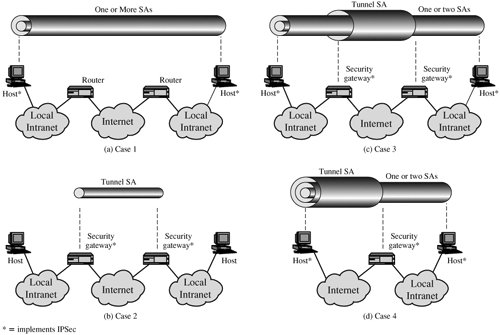Section 16.5. Combining Security Associations
16.5. Combining Security AssociationsAn individual SA can implement either the AH or ESP protocol but not both. Sometimes a particular traffic flow will call for the services provided by both AH and ESP. Further, a particular traffic flow may require IPSec services between hosts and, for that same flow, separate services between security gateways, such as firewalls. In all of these cases, multiple SAs must be employed for the same traffic flow to achieve the desired IPSec services. The term security association bundle refers to a sequence of SAs through which traffic must be processed to provide a desired set of IPSec services. The SAs in a bundle may terminate at different endpoints or at the same endpoints. Security associations may be combined into bundles in two ways:
The two approaches can be combined, for example, by having a transport SA between hosts travel part of the way through a tunnel SA between security gateways. One interesting issue that arises when considering SA bundles is the order in which authentication and encryption may be applied between a given pair of endpoints and the ways of doing so. We examine that issue next. Then we look at combinations of SAs that involve at least one tunnel. Authentication Plus ConfidentialityEncryption and authentication can be combined in order to transmit an IP packet that has both confidentiality and authentication between hosts. We look at several approaches. ESP with Authentication OptionThis approach is illustrated in Figure 16.9. In this approach, the user first applies ESP to the data to be protected and then appends the authentication data field. There are actually two subcases:
For both cases, authentication applies to the ciphertext rather than the plaintext. Transport AdjacencyAnother way to apply authentication after encryption is to use two bundled transport SAs, with the inner being an ESP SA and the outer being an AH SA. In this case ESP is used without its authentication option. Because the inner SA is a transport SA, encryption is applied to the IP payload. The resulting packet consists of an IP header (and possibly IPv6 header extensions) followed by an ESP. AH is then applied in transport mode, so that authentication covers the ESP plus the original IP header (and extensions) except for mutable fields. The advantage of this approach over simply using a single ESP SA with the ESP authentication option is that the authentication covers more fields, including the source and destination IP addresses. The disadvantage is the overhead of two SAs versus one SA. Transport-Tunnel BundleThe use of authentication prior to encryption might be preferable for several reasons. First, because the authentication data are protected by encryption, it is impossible for anyone to intercept the message and alter the authentication data without detection. Second, it may be desirable to store the authentication information with the message at the destination for later reference. It is more convenient to do this if the authentication information applies to the unencrypted message; otherwise the message would have to be reencrypted to verify the authentication information. One approach to applying authentication before encryption between two hosts is to use a bundle consisting of an inner AH transport SA and an outer ESP tunnel SA. In this case, authentication is applied to the IP payload plus the IP header (and extensions) except for mutable fields. The resulting IP packet is then processed in tunnel mode by ESP; the result is that the entire, authenticated inner packet is encrypted and a new outer IP header (and extensions) is added. Basic Combinations of Security AssociationsThe IPSec Architecture document lists four examples of combinations of SAs that must be supported by compliant IPSec hosts (e.g., workstation, server) or security gateways (e.g. firewall, router). These are illustrated in Figure 16.10. The lower part of each case in the figure represents the physical connectivity of the elements; the upper part represents logical connectivity via one or more nested SAs. Each SA can be either AH or ESP. For host-to-host SAs, the mode may be either transport or tunnel; otherwise it must be tunnel mode. Figure 16.10. Basic Combinations of Security Associations |
EAN: 2147483647
Pages: 209
